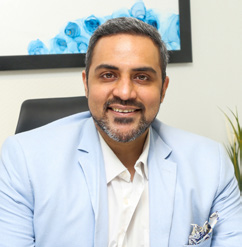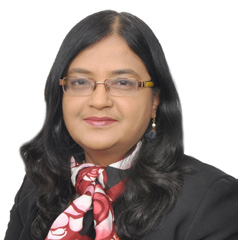Melasma management - Making a genius choice
A healthy cocktail of molecules and the right usage of products at the right time is the way forward, with absolutely no compromise on the use of sunscreen in the fight against melasma.
Diagnosing melasma and suggesting the appropriate course of action, especially topical applications, is a daunting task for practitioners as there are a number of factors that need to be taken into account.

Dr Aseem Sharma, Chief Dermatologist, Skin Saga Centre for Dermatology, Mumbai, highlights the fact that melasma has a prevalence rate of 3.3-47 per cent in skin of colour with complex pathomechanisms at play. “Earlier, all the research was centred around melanocytes but now we know that the epidermal melanin unit, which comprises keratinocytes, and dermal components such as fibroblasts and vascular endothelium have an important role to play in melasma treatment.” All the agents used in treatments, whether topical or oral, can be classified into four segments: 1. Does the agent remove keratinocytes? 2. Does the agent reduce the secretory function of melanocytes via Alpha MSH? 3. Does it reduce melanin synthesis by causing tyrosinase inhibition or interfering with any part of biomelanogenesis pathway? 4. Does it prevent melanosomes transfer from the keratinocytes to melanocytes?

Any discussion on treating melasma starts with the use of sunscreen. Dr Rashmi Sarkar, Director Professor, Department of Dermatology, Lady Hardinge Medical College and Associated Hospitals, New Delhi, says, “Since we (Indians) think that we have type 3 and 4 skin, we are probably protected by melanin and do not need sunscreen, especially as there are not as many skin cancer cases here as abroad. But sunscreen is a must-have to protect our skin against UVB and UVA rays to avoid photo carcinogenesis that occurs on our skin. Ideally, it should be a broad spectrum sunscreen with a mix of organic and inorganic sunscreen. I don’t call them physical sunscreen but inorganic with ingredients such as titanium dioxide or zinc oxide and if you can get iron oxide. Blue light is another area of concern but it is specific to diseases such as melasma. Infrared is another thing but all these have to be documented with evidence. In case of sunscreens, more ingredients need to be added to the spectrum. It is advisable to use a sunscreen of 30-50 SPF, a broadbased one, and a combination of organic and inorganic ingredients. A tinted one is ideal.”

Dr Malavika Kohli, Dermatology &
Aesthetics Director, Skin Secrets India, and Consultant Dermatologist Jaslok and Breach Candy Hospitals, Mumbai, expresses her views on triple combination therapy: “I am not a fan of the triple combination and I have almost retired it from my practice, using it selectively, mostly in cases of PIH. One could have it twice a week perhaps as a part of the maintenance regimen but that can also be done with plain hydroquinone, without having to use the steroid unless there is a reason for doing so. If there is resistance to hydroquinone 4% twice a week, then maybe one can use a triple combination in a very resistant case. However, I have found that with adequate counselling, correct sunscreen usage and with good cocktails that have other blenders, we can get good improvement on melasma. Some procedures and oral medication have helped us stay off triple combinations.

“Triple combination is still a gold standard in treatments of melasma, but in India, patients tend to abuse it,” adds Dr Abhishek De, Senior Consultant, WIZDERM Skin and Hair Clinic, Kolkata, and Associate professor, Calcutta National Medical College.
“Whenever I start a patient on triple combination, I never make it daily. Once you give it daily, there are chances that the patient will not like any other drug and will continue with the steroid molecule. Based on the treatment, I give it two or three times a week only.”
Dr Padmavathi Surapaneni, Dermatologist and Cosmetologist, Pragna Skin and Laser Clinic, Hyderabad, states, “Triple combination comes into my practice when a patient comes with refractive melasma from other practitioners or if it is refractive after using non-hydroquinone products. I first start with plain hydroquinone or double combination without a steroid.
As we know, melasma always relapses, so this is a reserve drug.” She adds, “I do like using the triple combination –a modified pigments regime – because it is good to get the lightening right at the beginning. I do use it in my practice but there is a lot of counselling involved, and after the fourth or sixth week, it might be just thrice a week. I explain in the beginning itself that this will be a rotational therapy.” The therapy for melasma is going to be lifelong.
Dr Sharma adds that he, too, finds triple combination appropriate for a subset of patients, with counselling as a major part of it.
Speaking about the non-steroid, nonhydroquinone spectrum, our experts have shared their opinions on the following ingredients:
Kojic Acid and Arbutin
● Dr Surapaneni: For PIH, kojic acid is my first choice but I prefer giving it at a higher concentration of 4%, and a cocktail with kojic acid has glycolic acid or tetanoid.
● Dr De: Kojic Acid and Arbutin are my favourite drugs. For five days a week, I keep my patients on non-hydroquinone, nonsteroidal combinations. I prefer giving kojic acid or arbutin as maintenance drugs as they are safer to use over a long period of time.
Mequinol
● Dr Kohli: It is the latest addition to our basket of non-lightening and non-brightening ingredients and it holds promise. I started using it pre-COVID. It is a good alternative when you want to use less of the tretinoin group. However, what happened during the pandemic is that a lot of melasma vanished as people were at home and stepped out only with a mask. The mask became a saviour of sorts. There was a lot of improvement in my melasma patients. Mequinol is a good molecule but it is mild and becomes more of a blender. I would still prefer retinol as you will see a difference in two to four weeks whereas with mequinol it will take six to eight weeks.
Tretinoin
● Dr Sarkar: Tretinoin is time tested. It is one of the first drugs to be approved not only for pigmentation but also for ageing. Photoageing is the new etiopathogenetic point that comes up with melasma. However, the Indian skin finds it difficult to tolerate tretinoin for a long time, especially the 0.05%. So, you can try adding adapalene. You can play it out and use any of the other agents with that.
Azelaic Acid - Underutilised and underrated?
It is important to understand the role of azelaic acid in the treatment of melasma, and the perspective of the brands that provide products based on this molecule.
Dr De states, “When azelaic acid was introduced in India, the brands that were available were not at par. Therefore, doctors have developed an apathy towards azelaic acid. Alternatively, they started using it at as low as 10%, which may not work as it has to be 15% and above. There are liposomal derivatives of azelaic acid, which are supported by strong data with reference to melasma and acne treatments. Moreover, it is safe to use over a longer periods of time, and during pregnancy, too. I like the molecule but the problem is that there are no brands providing good products.”
Dr Sarkar points out that the latest products with liposomal derivatives are supposed to be as good as hydroquinone, and they can be used for a long period without side-effects. Dr Surapaneni adds, “There is a double combination with azelaic acid and tretinoin, which became my first line of choice for both acne PIH and melasma.” Dr Kohli seconded the use of this combination in case of adult acne with melasma, but azelaic acid can also be combined with a lot of other ingredients such as arbutin, kojic acid, glycolic acid and salicylic acid.
The melasma arsenal
Our experts came on strongly in favour of the use of acids such as glycolic, mandelic and salicylic. Dr Sarkar cautions, “Be careful while using the acids. For glycolic acid, it is important to understand the burning sensation even before you can see the redness. Mandelic works best on post-acne pigmentation and melasma. Salicylic is versatile, especially for oily skin and postacne hyperpigmentation. All these acids work well both individually or in combination.
Speaking of polyhydroxy acids, Dr Kohli says, “We need more science, more evidence although it is well accepted in in-clinic treatments across age groups. It is also good for sensitive skin. It allows for a simple programme – exfoliation, cell renewal and hydration. Even if you have PHA in your skincare regimen, it serves quite a few functions. Therefore, it is versatile. PHA are likely to gain more popularity once they are backed by more evidence.” She further points out that mandelic acid was getting to be her favourite because when it is in a peel or cream or a face wash, it is good for somebody who is looking for quick results without using glycolic acid, especially on the body. It also works well with lasers. I alternate mandelic acid peels and creams with Q-switch lasers for body pigmentation.”
New on the block
● Niacinamide: It is a good lightening agent for maintenance and hydration. It cannot be a first line drug but can be in the cocktail as it stops the transfer of melanoma without reducing the synthesis of melanin.
● Silymarin: It is a much milder maintenance agent so it is ideal to use after prescribing stronger agents.
● Curcumin derivatives: There is no preparation with curcumin alone, it is always combined with other agents. It is important to see the correct percentage of the ingredient in a product and know how well it could work. But there is not enough evidence. Curcumin orally might be better than topical application.
● Brightenyl: It is promising and great as a blender. It is also a good moisturiser so you can put some actives over it.
Dr De explains that there is limited data available about the efficacy of extracts of liquorice, glabridin, mulberry, grapeseed, pine and soy as the only studies available are invitro and not in-vivo.
As for the use of oral agents, Dr Surapaneni recommends them for a time frame of four to six months, depending on how the patient responds to them. Currently, they are not prescribed for more than six months, but Dr Kohli suggests that practitioners can give a drug holiday and re-start the oral agents after a few months.
Dr Surapaneni also goes on to clarify that she does not replace topical sunscreen with oral sunscreens but she adds them to the patient’s care routine if the patients are working outdoors more. She regards oral sunscreen as an extra protection as they are strong on antioxidants and can prevent UV damage.
Dr Kohli points out that when oral sunscreens are prescribed, it adds to the expense for the patient who might end up compromising on the quality of the topical sunscreen, thus defeating the whole purpose of the therapy. It is best that the use of appropriate topical sunscreen in the right manner for melasma is recommended before bringing in oral sunscreen.
The journey of overcoming melasma is a long one and practitioners need to be aware of the latest developments in topical applications to be on top of the game. It can be concluded that a healthy cocktail of molecules and the right usage of products at the right time is the way forward, with absolutely no compromise on the use of sunscreen in the fight against melasma.